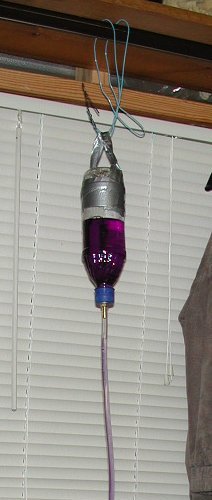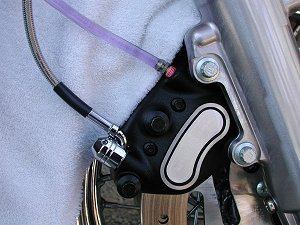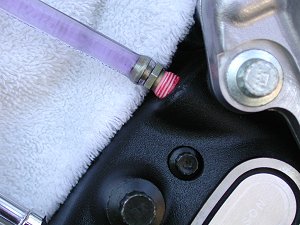Reverse Brake Bleeding
|
Do it backwards like the Pros do!
|
If conventional brake bleeding of the front brakes is leaving
you with less hair and more wrinkles between the eybrows, try
doing it backwards, like the professionals do!! If you have
opened the system by changing brake lines or working on the
calipers or the reservoir, this may be the only way to completely
rid the system of air.
Pro shops use a pressurized or "Bladder" setup to
simply fill the system from the bottom up, chasing the air
upwards, out the top, then some of the fluid is drawn back out or
pumped back out to eliminate any residual air that may be
pocketed in any upper recesses of the caliper.
With a few dollars and a trip to your local hardware store and
kitchen, you can build your own "Gravity Bleed" system
and do the job right the first time and be finished in an hour,
instead of a week!!
Think of this system as a medical "I.V." system, just
like the one they give you blood or fluids with. You fill a
reservoir with fluid, attach it to the caliper bleeder valve (nipple),
then either let gravity do the work, or lightly apply squeeze
pressure by hand. Very simple, and extremely effective.
Some
items you will need:
1.) A typical 16 or 20 oz water bottle,
clean and dry.
2.) A 3/16" Brass Hose Barb from
the hardware store (with 1/8" pipe threads on the
back end).
3.) A 1/2" brass Lamp base nut (listed
with 1/8" ISP threads (to secure the hose barb with.)
4.) Two used banjo crush washers (these
are a perfect size, but other washers will work.
5.) 6 feet of 3/16" inside diameter
clear tubing.
6.) (Optional) 1/4"
outside brass needle valve.
7.) A roll of Duct tape and a Coat
Hangar or rope for suspending the bottle.
8.) Turkey baster (for removing excess
fluid from reservoir.
9.) Some Teflon plumber's tape for
sealing the bleeder valve threads.
|

|
Drill a hole in the cap of the water bottle and attach the
hose barb to the cap, using the brass lamp nut and the two used
banjo washers. wrap a loop of duct tape over the bottom of the
bottle so you will have something to hang it upside down by.
Pour in the brake fluid. Attach the clear tubing to the cap. (I
used a small needle valve near the free end of the hose just to
make things work a little cleaner, since I had to bleed both
sides of my dual disc system, but the needle valve is not
necessary.)
Remove the caliper
bleeder nipple, clean its threads, and then wrap a short
length of Teflon tape around the threads to help seal it
from air entry or fluid leakage during the process, then
reinstall the nipple to the caliper.
|
First of all, use common sense when setting up to bleed. Air
migrates upward in a liquid system, so tilt your handlebars, turn
your handlebars, and or reposition your master cylinder so that
the banjo fitting is BELOW the lowest point of the reservoir.
Now, after removing the reservoir cap, loosen the caliper bleeder
valve to open it, and attach the free end of the clear tubing to
it. It helps to let the clear tubing fill up with fluid right to
the end before attaching to the bleeder valve, just to reduce the
introduction of air into the brake system.
Raise and secure the upside down bottle to a level just above the
reservoir, then take a small pointed punch or other device and
poke a small "breather" hole in the bottom of the
bottle (which is now the high end), so it can draw in air as the
fluid flows downward. Make sure that the clear tubing makes a
constant uphill path to the bottle so that air in the tubing will
work its way to the top and into the bottle.

|

|
You can help and speed the process by taking the bottle in
your hand and while holding your thumb over the breather hole,
squeeze the bottle gently, and watch the reservoir as it fills.
You can also "suck" fluid back through by moving your
thumb off the hole, then squeezing the bottle to remove its air
content, then hold your thumb over the hole and manipulate the
bottle to draw fluid back in with a slight vacuum pressure
When the system is initially filled with fluid, let it sit
undisturbed for 15 minutes, then there will be three air bubbles
left in the system. One small one just below each bleeder nipple
at the calipers, and one big one at the master cylinder banjo
fitting.
Now, with the system full, you can "tickle" that bubble
out of the banjo by LIGHTLY squeezing the lever only a SLIGHT
amount (may 1/4"). Just "wiggle" the lever in and
out at the very outward portion of its travel, and it will draw
that bubble upward. If you fully squeeze the lever, or squeeze it
hard, you are forcing that banjo bubble down into the brake line,
and it has to start climing back up all over again.
When you can't "tickle" any more air through the tiny
orifice in the reservoir, reverse sqeeze some more fluid through
the system with the bottle, and watch for any new bubbles. If you
don't get any new ones, and can't "tickle" any more out
from the top, then crack open the caliper bleeder and SLOWLY
bleed any remaining caliper air out from the bottom
conventionally. Finish off the other caliper and test the system.
Dual Disc Notes:
If your system consists of
dual brake discs and calipers, work the left
caliper first, until fluid begins to reach the
reservoir, then swap over and work the right,
until all air is evacuated, then finally, go back
and lever bleed the left again to make certain
there is no air left in the caliper itself.
|
|






